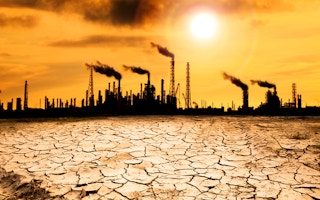At a sustainability conference earlier this month in New Delhi, a senior representative of India’s Ministry of Petroleum stood up to give a speech (fun fact: the Petroleum Minister in India doubles as the Environment Minister). Among his sleep-inducing bureaucrat-speak, he squeezed in a bizarre tirade against clean energy, which according to him, must be evaluated carefully given its “occasionally horrible impacts on health”.
As an example of these so-called harmful effects, the speaker gave the example of biomass-fired cookstoves and the toxic gases these apparently emit.
The remark was either incredibly self-serving or incredibly ignorant and illustrates one aspect of the failure of the climate movement. Traditional cook stoves are in fact dirty and lethal, no relation to clean energy cook stoves which save lives amongst women and children by improving indoor air quality.
Some 1.5 billion people (half of whom are in India) burn wood and other biomass to cook their food or heat their dwellings with traditional cooking stoves. These account for 13 per cent of global energy consumption and their toxic emissions kill 1.6 million people each year, according to the World Health Organization. More efficient biomass stoves are readily available (financed with donor funds).
How is it that a figure of such influence can peddle this piffle with impunity? Why are national and global policymakers so infrequently challenged when pronouncing nonsense from their bully pulpits? Is the global climate movement so deeply on the defensive that it can no longer mount a defence?
There is no disputing the climate movement’s breadth, depth, diligence, passion or commitment. Crucially, it’s also right, fighting for nothing less than the future of our civilisation. But playing out in slow motion in front of our eyes, we are witnessing its complete collapse. Sustainability conferences hijacked by oil officials and sponsored by Big Oil are but symptoms of a deeper malaise.
“
No one is listening, certainly not politicians, business or institutional investors. The latter, who control $70 trillion of investment assets, are ignoring climate risks in their investment analysis
Form of climate movement
To understand the climate movement’s failure, we must first understand its form. Climate advocates come in numerous varieties. Advocacy organizations include 350.org, Greenpeace, Friends of the Earth, the World Wildlife Fund, the Sierra Club and many others. These are massive, with Greenpeace alone having more than 2.9 million donors and a 2012 budget of over $300 million.
Some are organized in global networks (such as the Climate Action Network, a worldwide network of over 850 non-governmental organisations in more than 90 countries). All are supported by the vast intellectual power of a maze of think tanks relentlessly publishing thoughtful, fact-based research about our climate crisis, including Tsinghua University (China), The Energy and Resources Institute (India), the Institute for Sustainable Development and International Relations (Europe), the World Resources Institute and Brookings (US) and many, many others.
At university campuses around the world, a “divest” movement (calling for divestment from fossil fuel investments) is pushing as hard as it can. In parallel, shareholder activists such as the Asset Owners Disclosure Project, the Carbon Disclosure Project, the Global Investor Coalition on Climate Change and others are pushing for sustainable business and investment practices, for increased disclosure of climate risks as well as for government policies and investment practices that address the risks and opportunities of climate change.
An extensive and costly UN infrastructure is also fully deployed. The world has formally known that it is facing catastrophic climate change since at least 1992, the date the United Nations Rio Summit took place and we decided to take action, principally via the UN Framework Convention on Climate Change. Since then, this has been supplemented by a spider web of supranational bodies, international conventions, accords, protocols, clubs and investment funds, in addition to the World Bank and the IMF, whose bosses periodically make strident calls in support of the climate movement and of climate action.
Little to report
So what has this massive climate movement achieved? Sadly, its 25-year track record is one of failure where it matters.
Climate vulnerability has increased dramatically on its watch. Emissions have kept increasing since 1990, with carbon now building up in the atmosphere faster than ever, from 353 parts per million (or ppm) of carbon dioxide in 1990 to nearly 398 ppm in January 2014 (anything above 350 ppm is widely regarded as unacceptably risky).
The Earth’s main ice sheets have been melting at a rate of 362 billion tonnes per year between 2002 and 2011 – a nearly six-fold increase from the melting rate of 64 billion tonnes per year between 1992 and 2001 and a complete change from the historic accumulation of ice. Biodiversity in the tropics has decreased by 30 per cent since 1992, due to deforestation and agricultural land-use change, and so on. These are not spikes, or “possible indications of a trend”. These events are happening now.
And yet, no one is listening, certainly not politicians, business or institutional investors. The latter, who control $70 trillion of investment assets, are ignoring climate risks in their investment analysis: the Asset Owners Disclosure Project’s 2013/14 Index reveals that 80 per cent of the 460 institutions it rates are either D rated (abysmal) or X rated (doing nothing) and a further 540 funds did not disclose sufficient information to allow a rating and we must assume they would have been X rated as well.
Despite the increasing frequency of extreme weather events like United Kingdom’s recent catastrophic flooding, each of which cost billions of dollars in damages, the media gives only scant attention to climate change; and citizens don’t care enough to significantly alter their behaviour, let alone mobilize en masse.
The next chapter
Cumulative worldwide investments in new fossil-fuel extraction and processing are expected to be three times the investments in renewables between 2012 and 2035 ($22 trillion versus $7 trillion). Emissions will continue to soar and Planet Earth will be far less liveable. Regional differences in the impacts of climate change, some of which are already evident, will almost certainly trigger geopolitical instability.
We have had a clear breakdown in global governance as it relates to the most critical issue of our lifetime. Governments are not delivering because they are incapable of looking sufficiently far into the future. Civil society, academia, scientists (and a few businesses) are getting nowhere with advocacy, propagation of scientific facts, protests or demonstrations. It’s time for the climate movement to face up to its colossal failure, examine why it failed, re-group and re-emerge with a strategy to ensure it succeeds. Human civilization’s very survival depends on it.
This piece is the first in a series by Assaad Razzouk on reviving and reinventing the global climate movement. It originally appeared in The Independent.









